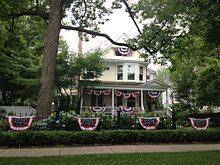- 4th of July decorations in Roche Harbor include Canadian and U.S. flags and red, white and blue bunting.
- NSE Eridge-Edenbridge celebrations (1988) with Red, White and Blue commemorating the Hundred Years of the Line.
- Example of personalised nursery bunting in the UK


Bunting refers to decorative flags, wide streamers, or draperies made of fabric, or of plastic, paper or cardboard in imitation of fabric. Bunting is also a collection of flags, and the fabric used to make flags. The fabric was originally a specific type of lightweight worsted wool fabric, but can also be cotton.


